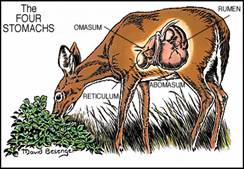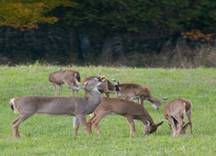The White-Tailed Deer
Nutrition
The white-tailed deer is an herbivore or plant eater. It generally has a range of around one mile where it feeds. It feeds in the early morning hours and in the late afternoon. A deer's diet changes depending on its habitat and the season. It eats green plants in the spring and summer. In the fall, it eats corn, acorns and other nuts. In the winter, it eats whatever it can to survive; like twigs and grass if it can reach it through the snow. Deer do not have the ability to store extensive fat reserves in the body like many other mammals. Food shortages during the winter months, due to snow or over population, can lead to malnutrition and the deer begins to starve and eventually die. When deer are unable to sustain its body weight, self-absorption sets in (eats away at tissues from the inside). Deer that are starving become extremely susceptible to disease and predation. The starvation of deer is too common and state and government officials are increasing developing ways to deter the well being of these animals; i.e. longer hunting seasons and deer reserves or parks. It is not uncommon for as many as 300,000 to 400,000 deer to starve in the U.S. in a year. The first to die are the fawns and the older deer.

The white-tailed deer is a ruminant, like cows and goats. Its stomach has four chambers for digesting food. Vegetation with high sugar or fat content (fruits, nuts, fungi) is easily digested. However, vegetation contains cellulose, which isn't easily digested by stomach enzymes. Deer digestive tract contains bacteria and protozoa that help ferment and break down the food and help with nutritional value. In the first two chambers, the rumen and the reticulum, food is mixed with bile to form the cud . The cud is regurgitated and re-chewed and swallowed. It passes through the rumen to the omasum where water is removed. Finally, the food enters the last chamber, the abomasum, where it is sent on to the small intestine where the nutrients in the food are absorbed. This digestive system lets the white-tailed deer eat foods like woody plants that other animals can't digest. If deer have enough food, water and shelter, their population can grow very quickly.

Deer from the northern states are generally larger than deer in other states. There is an estimated 500 different plants that the deer population in the U.S. consumes. Deer in Wisconsin can wreak havoc on farm lands eating corn in late summer and fall. They also like oak acorns, live oak leaves, beans, apples, grass and many others. Sometimes these foragers are the meal for carnivores like the grey wolf, coyotes, bear, and even mountain lion in some regions.